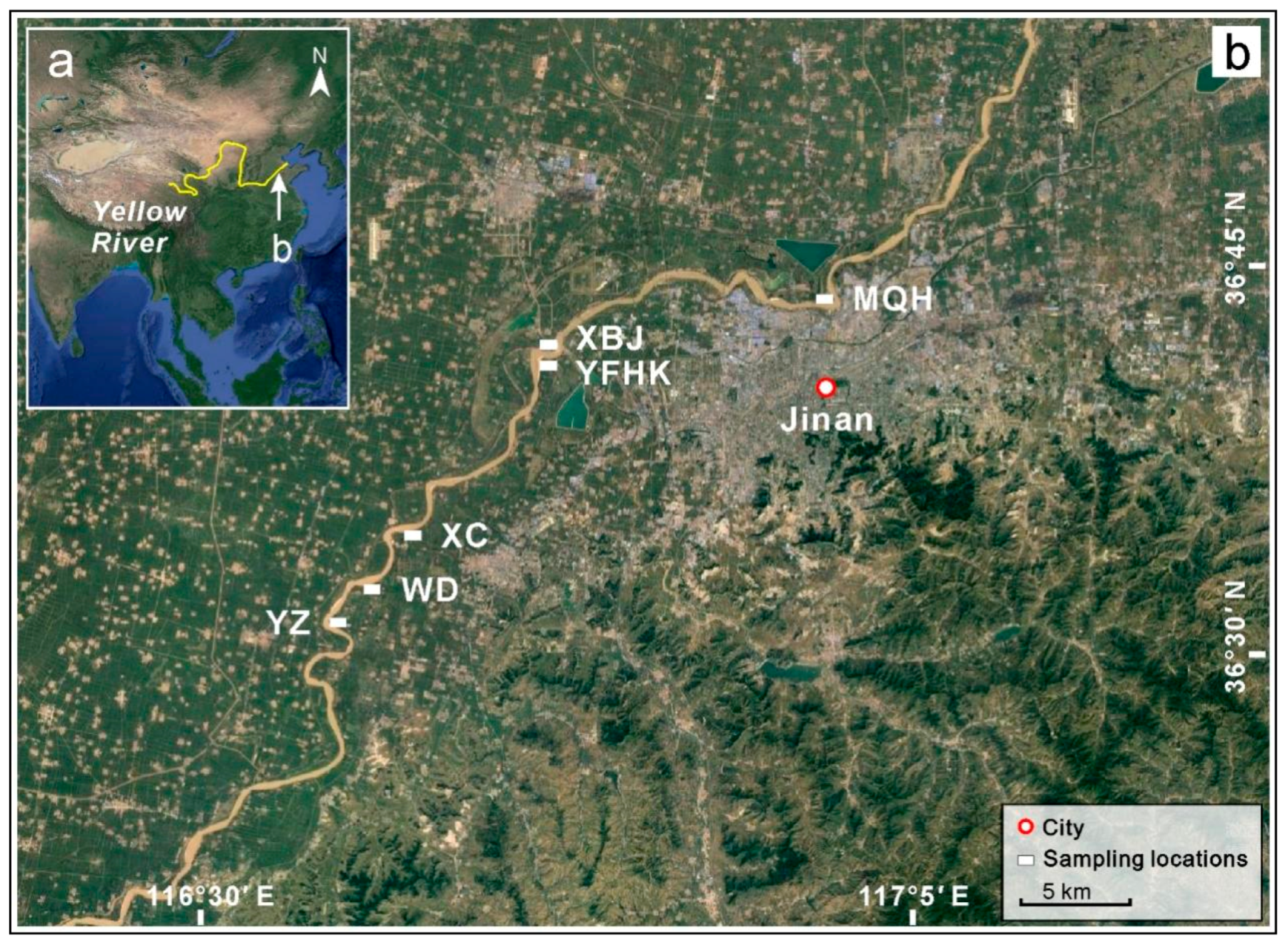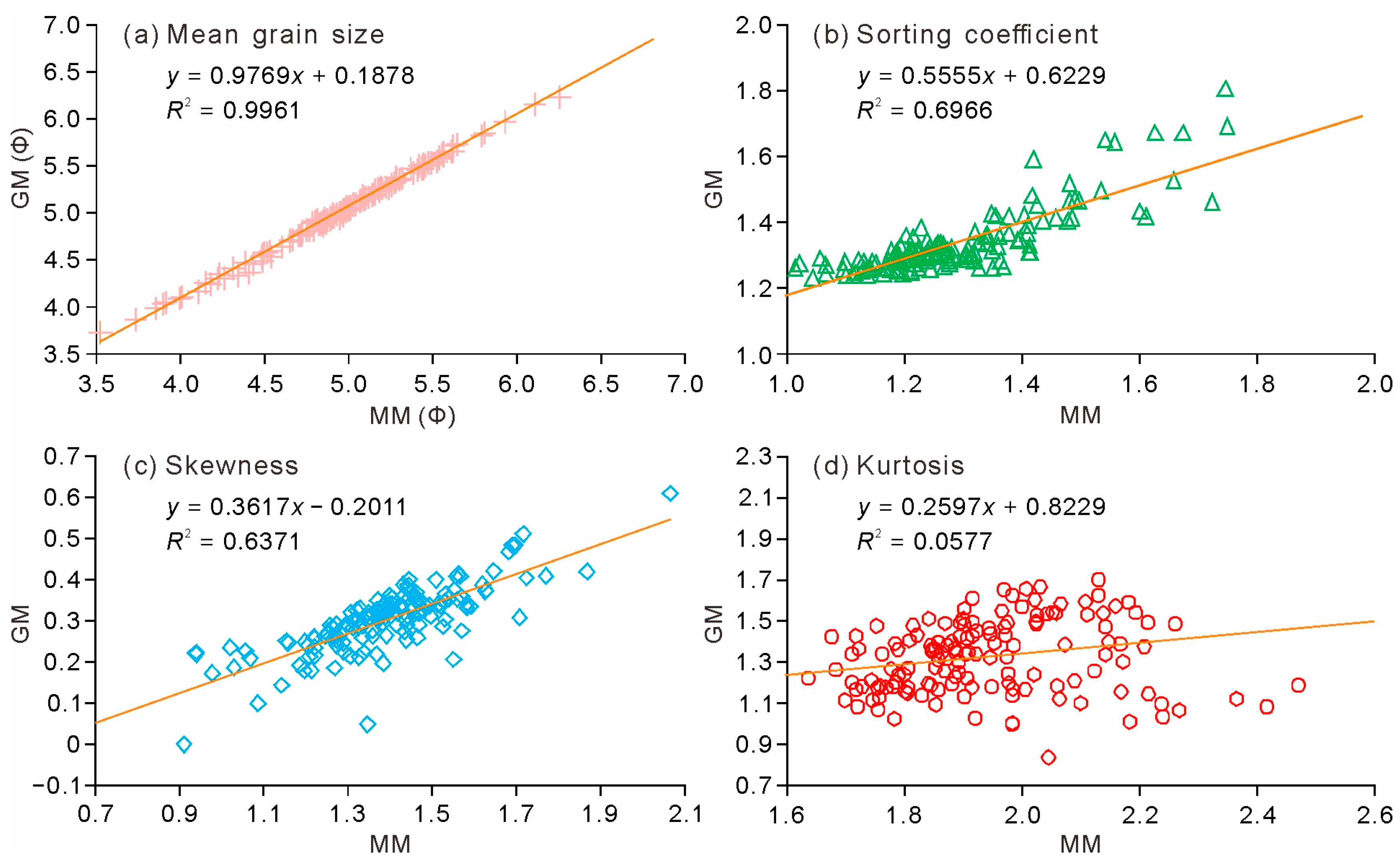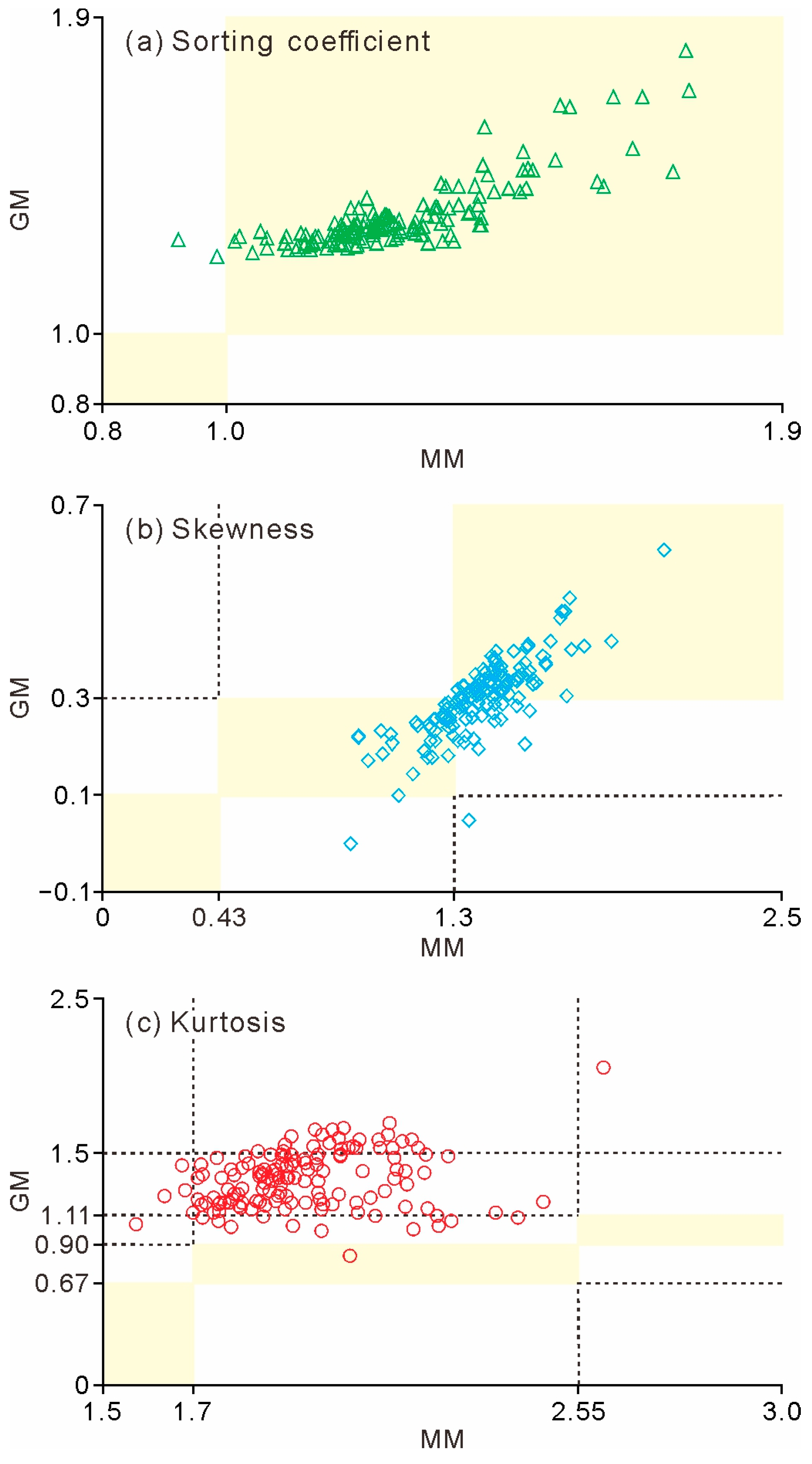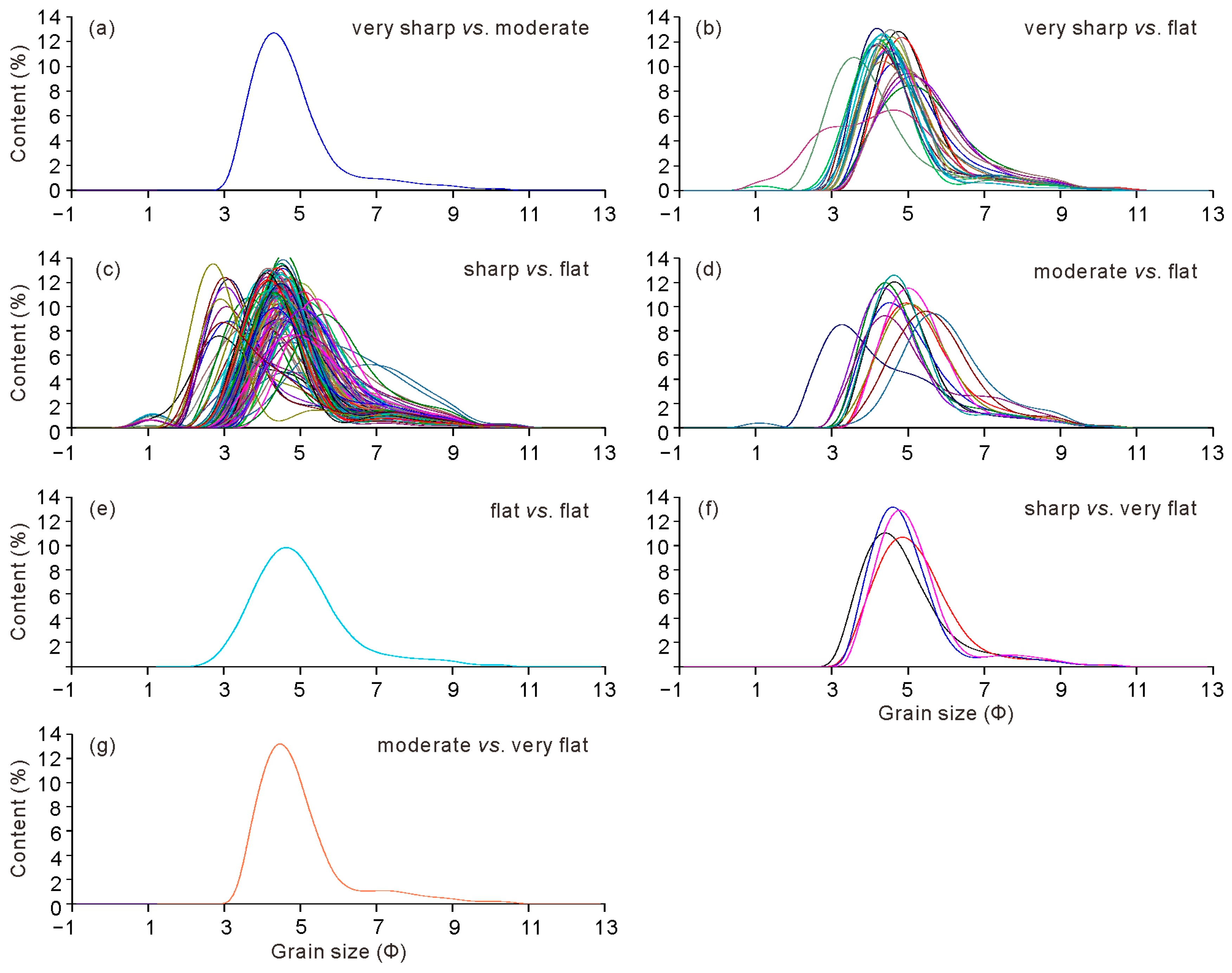Comparative Grain Size Analysis of Modern Flood Sediments Based on Graphic and Moment Methods in the Lower Yellow River (Huang He), China
Abstract
1. Introduction
2. Materials and Methods
2.1. The Study Area
2.2. Samples Recovered from Modern Flood Sediments
2.3. Grain Size Analysis
2.4. The Calculation Methods of Grain Size Parameters
3. Results
3.1. Quantitative Characteristics and Analysis of Grain Size Parameters
3.2. Qualitative Analysis of Grain Size Parameters
4. Discussions
4.1. The Differences between the Results of the Graphic Method (GM) and Moment Method (MM)
4.2. Comparison and Selection of Grain Size Information Extraction between Graphic and Moment Methods for Flood Sediments
4.3. Implications
5. Conclusions
- The modern flood sediments observed in the lower Yellow River primarily consisted of fine particles with a mean grain size of 3.52–6.26 Φ (as computed by the MM), denoting silty sand, and sorting coefficients that ranged from 1.22 to 1.81, indicating poor sorting. The skewness values ranged from 0.91 to 2.07, with an average of 1.39, indicating extremely positive skewness. Meanwhile, the kurtosis values varied from 0.84 to 2.06, with an average of 1.33, suggesting sharp peaks.
- The mean grain sizes calculated using both the GM and MM exhibited a strong correlation; therefore, both methods can be used to distinguish the grain size characteristics of flood sediment in the lower Yellow River. Furthermore, the sorting coefficient between the two methods was strongly correlated, reinforcing their consistency when providing qualitative sample descriptions.
- The skewness and kurtosis parameters computed using the GM and MM exhibited moderate correlations and no correlations, respectively. Considering this, from a theoretical standpoint, it is recommended to utilize the MM to analyze the skewness of flood sediments in the lower Yellow River, as it would more accurately reflect the overall sediment grain size information. Moreover, the GM should be employed to analyze the kurtosis parameters, as this method emphasizes the principal dynamic characteristics of flood sediment deposition. The above understanding also has important reference significance for the grain size analysis of fine-grained flood sediments in other rivers of the world.
Author Contributions
Funding
Institutional Review Board Statement
Informed Consent Statement
Data Availability Statement
Acknowledgments
Conflicts of Interest
References
- Folk, R.L.; Ward, W.C. Brazos river bar: A study in the significance of grain size parameters. J. Sediment. Res. 1957, 27, 3–26. [Google Scholar] [CrossRef]
- Hartmann, D.; Flemming, B. From particle size to sediment dynamics: An introduction. Sediment. Geol. 2007, 202, 333–336. [Google Scholar] [CrossRef]
- Folk, R.L. A review of grain size parameters. Sedimentology 1966, 6, 73–97. [Google Scholar] [CrossRef]
- Pye, K. Aeolian Dust and Dust Deposits; Academic Press: Cambridge, MA, USA, 1987; p. 68. [Google Scholar]
- Prins, M.A.; Postma, G.; Weltje, G.J. Controls on terrigenous sediment supply to the arabian sea during the late quaternary: The makran continental slope. Mar. Geol. 2000, 169, 351–371. [Google Scholar] [CrossRef]
- Chen, F.; Feng, Z.; Zhang, J. Loess particle size data indicative of stable winter monsoons during the last interglacial in the western part of the chinese loess plateau. Catena 2000, 39, 233–244. [Google Scholar] [CrossRef]
- Michael, N.A.; Zühlke, R. Source-to-sink: Regional grain size trends to reconstruct sediment budgets and catchment areas. Basin Res. 2022, 34, 393–410. [Google Scholar] [CrossRef]
- Friedman, G.M.; Sanders, J.E. Principles of Sedimentolog; Wiley: New York, NY, USA, 1978; pp. 78–80. [Google Scholar]
- McManus, J. Grain size determination and interpretation. In Techniques in Sedimentology; Blackwell: Oxford, UK, 1988; pp. 63–85. [Google Scholar]
- Blott, S.J.; Pye, K. GRADISTAT: A grain size distribution and statistics package for the analysis of unconsolidated sediments. Earth Surf. Process. Landf. 2001, 26, 1237–1248. [Google Scholar] [CrossRef]
- Chen, Q.; Tang, W.; Xue, C.; Yang, Y.; Gao, W.; Yang, J.; Jia, J. The Φ Value Expresses Granularity and the Unit Problem of the Sorting Coefficient. Acta Sedimentol. Sin. 2023. (In Chinese) [Google Scholar] [CrossRef]
- Jia, J.; Gao, S.; Xue, Y. Grain-size parameters derived from graphic and moment methods: A comparative study. Oceanol. Et Limnol. Sin. 2002, 33, 577–582. (In Chinese) [Google Scholar]
- Wang, Z.; Yu, D.; Luo, F.; Yang, H. Comparison of grain size parameters from graphical and moment methods for surface sediments in Quanzhou Bay. Mar. Geol. Front. 2016, 32, 19–27. (In Chinese) [Google Scholar]
- Li, G.; Du, R.; Tang, J.; Li, Z.; Xia, Q.; Shi, B.; Zhou, L.; Yang, Y.; Zhang, W. Comparison of the graphic and moment methods for analyzing grain-size distributions: A case study for the Chinese inner continental shelf seas. Int. J. Sediment Res. 2022, 37, 729–736. [Google Scholar] [CrossRef]
- Li, G.; Liang, R.; Tong, C.; Wang, H.; Xia, Q.; Li, Z.; Tang, J. Qualitative comparative analysis on grain-size parameters of derived from graphic and moment methods: A case study of the surficial sediment of coastal beaches of Qiongzhou Strait. Haiyang Xuebao 2023, 45, 98–109. (In Chinese) [Google Scholar]
- Cai, G.; Fan, D.; Shang, S.; Wu, Y.; Shao, L. Difference in grain-size parameters of tidal deposits derived form the graphic and its potential causes. Mar. Geol. Quat. Geol. 2014, 34, 195–204. (In Chinese) [Google Scholar]
- Dai, J.; Zhang, P. Comparison and its significance of grain-size parameters of several of sediments with graphic method and moment method. J. Geol. 2017, 41, 239–244. (In Chinese) [Google Scholar]
- Rea, D.K.; Janecek, T.R. Late cenozoic changes in atmospheric circulation deduced from north pacific eolian sediments. Mar. Geol. 1982, 49, 149–167. [Google Scholar] [CrossRef]
- Yang, Y.; Gao, S.; Zhou, L.; Wang, Y.W.; Li, G.C.; Wang, Y.P.; Han, Z.C.; Jia, P.H. Classifying the sedimentary environments of the Xincun Lagoon, Hainan Island, by system cluster and principal component analyses. Acta Oceanol. Sin. 2017, 36, 64–71. [Google Scholar] [CrossRef]
- Zhou, L.; Gao, S.; Yang, Y.; Zhao, Y.; Han, Z.; Li, G.; Jia, P.; Yin, Y. Typhoon events recorded in coastal lagoon deposits, southeastern Hainan Island. Acta Oceanol. Sin. 2017, 36, 37–45. [Google Scholar] [CrossRef]
- Yuan, P.; Wang, H.J.; Wu, X.; Bi, N.S. Grain-size distribution of surface sediments in the Bohai sea and the northern yellow sea: Sediment supply and hydrodynamics. J. Ocean Univ. China 2020, 19, 589–600. [Google Scholar] [CrossRef]
- Sun, Q.; Zhou, J.; Xiao, J. Grain-size characteristics of lake Daihai sediments and its paleaoenvironment significance. Mar. Geol. Quat. Geol. 2001, 21, 93–95. (In Chinese) [Google Scholar]
- Yellow River Conservancy Commission of the Ministry of Water Resources. Yellow River Sediment Bulletin. 2021. Available online: http://www.yrcc.gov.cn/ (accessed on 22 May 2023).
- Ministry of Water Resources of the People’s Republic of China. Chinese River Sediment Bulletin (Yangze River, Yellow River, 2000). Available online: http://www.mwr.gov.cn/sj/tjgb/zghlnsgb/201612/t20161222_776055.html (accessed on 22 May 2023).
- Fan, Y.; Yu, S.; Wang, J.; Li, P.; Chen, S.; Ji, H.; Li, P.; Dou, S. Changes of Inundation Frequency in the Yellow River Delta and Its Response to Wetland Vegetation. Land 2022, 11, 1647. [Google Scholar] [CrossRef]
- Baker, V.R. Palaeoflood hydrology in a global context. Catena 2006, 66, 161–168. [Google Scholar] [CrossRef]
- Swan, D.; Clague, J.J.; Luternauer, J.L. Grain-size statistics II: Evaluation of grouped moment measures. J. Sediment. Petrol. 1979, 49, 487–500. [Google Scholar]
- Zhao, Z. Comparison of calculating methods for grain-size distribution parameters of sediments in South Yellow Sea. Mar. Geol. Quat. Geol. 1992, 12, 95–107. (In Chinese) [Google Scholar]
- Chiverrell, R.C.; Sear, D.A.; Warburton, J.; Macdonald, N.; Bradley, J. Using lake sediment archives to improve understanding of flood magnitude and frequency: Recent extreme flooding in northwest UK. Earth Surf. Process. Landf. 2019, 44, 2366–2376. [Google Scholar] [CrossRef]
- Liu, Z.; Long, H. Comparing study on the grain-size parameters estimated from the graphical method and the moment method of the sediments from South China Sea. Period. Ocean Univ. China 2009, 39, 313–316+336. (In Chinese) [Google Scholar]
- Liu, Z.J.; Gong, Y.F.; Zhou, S.W.; Yu, J.; Liu, Y.G.; Yin, R.G.; Cheng, Y.S. A comparative study on the grain-size parameters of marine sediments derived from three different computing methods. Acta Oceanol. Sin. 2013, 35, 179–188. (In Chinese) [Google Scholar]
- Xu, X.Y.; Yi, L.; Yu, H.J.; Li, N.S.; Shi, X.F. The differences of grain-size parameters estimated with graphic and moment methods in coastal sediments. Acta Oceanol. Sin. 2010, 32, 80–86. (In Chinese) [Google Scholar]
- Li, G.; Li, Z.; Zhu, S.; Zhang, H.; Zeng, C. Comparative Study on Grain-size Parameters of Marine Sediment Derived from Graphic and Moment Methods. J. Guangdong Ocean Univ. 2020, 40, 96–101. (In Chinese) [Google Scholar]
- Yang, D.; Ge, Y.; Xie, Y.; Zhan, D.; Li, Z. Sedimentary records of large Holocene floods from the middle reaches of the Yellow River, China. Geomorphology 2000, 33, 73–88. [Google Scholar] [CrossRef]
- Huang, C.C.; Pang, J.; Zha, X.; Zhou, H. Holocene Palaeoflood Events recorded by slackwater deposits along the Lower Jinghe River Valley, Middle Yellow River Basin, China. J. Quat. Sci. 2012, 27, 485–493. [Google Scholar] [CrossRef]
- Meade, R.H.; Dunne, T.; Richey, J.E.; Santos, U.D.M.; Salati, E. Storage and Remobilization of Suspended Sediment in the Lower Amazon River of Brazil. Science 1985, 228, 488–490. [Google Scholar] [CrossRef]
- Heimann, D.C.; Sprague, L.A.; Blevins, D.W. Trends in suspended-sediment loads and concentrations in the Mississippi River Basin, 1950–2009. In Scientific Investigations Report; USGS: Reston, VA, USA, 2011. [Google Scholar]
- Yang, Y.; Li, Y.; Sun, Z.; Fan, Y. Trends and causes of suspended sediment concentration variation in the turbidity maximum zone at the Yangtze River Estuary. Acta Geogr. Sin. 2013, 68, 1240–1250. (In Chinese) [Google Scholar]
- Darby, S.E.; Dunn, F.E.; Nicholls, R.J.; Rahman, M.; Riddy, L. A first look at the influence of anthropogenic climate change on the future delivery of fluvial sediment to the Ganges-Brahmaputra-Meghna delta. Environ. Sci. Process. Impacts 2015, 17, 1587–1600. [Google Scholar] [CrossRef]





| Grain Size Parameters | Calculation Method | Min. | Max. | Average | Standard Deviation |
|---|---|---|---|---|---|
| Mean grain size | GM | 3.74 | 6.25 | 5.03 | 0.45 |
| MM | 3.52 | 6.26 | 4.95 | 0.46 | |
| Sorting coefficient | GM | 1.22 | 1.81 | 1.34 | 0.10 |
| MM | 0.92 | 1.75 | 1.28 | 0.15 | |
| Skewness | GM | 0 | 0.61 | 0.30 | 0.08 |
| MM | 0.91 | 2.07 | 1.39 | 0.18 | |
| Kurtosis | GM | 0.84 | 2.06 | 1.33 | 0.19 |
| MM | 1.58 | 2.61 | 1.95 | 0.17 |
Disclaimer/Publisher’s Note: The statements, opinions and data contained in all publications are solely those of the individual author(s) and contributor(s) and not of MDPI and/or the editor(s). MDPI and/or the editor(s) disclaim responsibility for any injury to people or property resulting from any ideas, methods, instructions or products referred to in the content. |
© 2023 by the authors. Licensee MDPI, Basel, Switzerland. This article is an open access article distributed under the terms and conditions of the Creative Commons Attribution (CC BY) license (https://creativecommons.org/licenses/by/4.0/).
Share and Cite
Tang, L.; Zheng, S.; Wang, H.; Zhang, W. Comparative Grain Size Analysis of Modern Flood Sediments Based on Graphic and Moment Methods in the Lower Yellow River (Huang He), China. Appl. Sci. 2023, 13, 8934. https://doi.org/10.3390/app13158934
Tang L, Zheng S, Wang H, Zhang W. Comparative Grain Size Analysis of Modern Flood Sediments Based on Graphic and Moment Methods in the Lower Yellow River (Huang He), China. Applied Sciences. 2023; 13(15):8934. https://doi.org/10.3390/app13158934
Chicago/Turabian StyleTang, Liang, Shuwei Zheng, Haijun Wang, and Wentong Zhang. 2023. "Comparative Grain Size Analysis of Modern Flood Sediments Based on Graphic and Moment Methods in the Lower Yellow River (Huang He), China" Applied Sciences 13, no. 15: 8934. https://doi.org/10.3390/app13158934
APA StyleTang, L., Zheng, S., Wang, H., & Zhang, W. (2023). Comparative Grain Size Analysis of Modern Flood Sediments Based on Graphic and Moment Methods in the Lower Yellow River (Huang He), China. Applied Sciences, 13(15), 8934. https://doi.org/10.3390/app13158934





